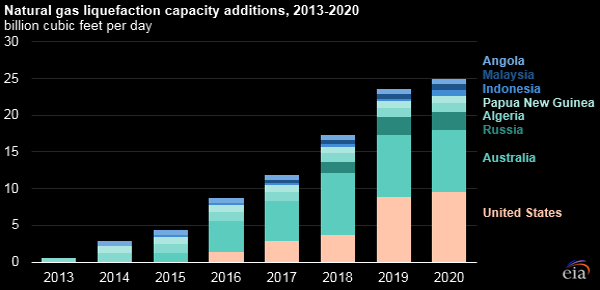
GLOBAL LNG TRADE UP

EIA - Global trade in liquefied natural gas (LNG) reached 38.2 billion cubic feet per day (Bcf/d) in 2017, a 10% (3.5 Bcf/d) increase from 2016 and the largest annual volume increase on record.
In 2017, there were 19 LNG exporting countries and 40 LNG importing countries. Australia and the United States were among the countries with the largest increases (2.7 Bcf/d combined) in 2017 LNG exports.
Besides Australia and the United States, several other countries also increased LNG exports in 2017. The return to service of Angola LNG and increases from several countries including Nigeria, Malaysia, Algeria, Russia, and Brunei added another 1.4 Bcf/d of LNG exports, more than offsetting a combined decline of 0.6 Bcf/d in exports from Qatar, Indonesia, Norway, Peru, the United Arab Emirates, and Trinidad.
Asian countries led the growth in global LNG imports, accounting for 74% (2.6 Bcf/d) of the increase in 2017. Japan remains the largest LNG importer, importing 11.0 Bcf/d in 2017. China had the largest growth in LNG imports globally (1.5 Bcf/d) and became the world's second-largest LNG importer in 2017, surpassing South Korea. LNG imports also increased in South Korea, Pakistan, Taiwan, and Thailand, which collectively added 1.0 Bcf/d.
Europe increased its LNG imports by 1.4 Bcf/d, primarily in Spain, Italy, Portugal, France, and Turkey. LNG imports in the United Kingdom declined by 0.34 Bcf/d (35%), one of only two countries in Europe to experience declines in LNG imports, as lower winter heating demand from the residential sector and increased electricity generation from wind reduced the demand for natural gas.
LNG imports in South America (Brazil, Argentina, Chile, and Colombia) remained essentially unchanged from 2016. In North America, Mexico's LNG imports increased by 17% as the country continued to rely on LNG supplies amid declining domestic production and construction delays in infrastructure connecting the Mexican domestic grid to natural gas pipeline exports from the United States. LNG imports into the Middle East declined by 9%, primarily to Egypt and the United Arab Emirates (Dubai).
Growth in LNG trade was driven in part by new liquefaction capacity commissioned in Australia, the United States, and Russia, collectively adding 3.4 Bcf/d of liquefaction capacity. The world's first floating liquefaction plant, Malaysia's PFLNG Satu (0.2 Bcf/d capacity), was also commissioned in 2017. Since 2013, the United States and Australia have added a combined 9.67 Bcf/d of new liquefaction capacity, with another 8.3 Bcf/d expected to be completed by 2020. Including additions in the United States and Australia, liquefaction projects currently under construction are projected to increase global liquefaction capacity by 13.5 Bcf/d by 2022.
The United States is expected to add 6.05 Bcf/d of new liquefaction capacity by 2021, in addition to 3.5 Bcf/d already in operation at Sabine Pass and Cove Point. This year the Elba Island liquefaction project in Georgia is expected to commission the first 6 of 10 small modular liquefaction units, or trains, with a combined capacity of 0.2 Bcf/d. New trains at Cameron, Freeport, and Corpus Christi—all along the U.S. Gulf Coast—are expected to be commissioned in the next three years.
-----
Earlier:

2018, June, 8, 13:05:00
U.S. GAS EXPORT UPEIA - U.S. exports of natural gas, including exports via pipeline and as liquefied natural gas (LNG), averaged 9.6 billion cubic feet per day (Bcf/d) in the first quarter of this year, |

2018, June, 4, 13:05:00
BANGLADESH LNG UPEIA - In April 2018, Bangladesh became the newest country to begin imports of liquefied natural gas (LNG). In the next two years, six more countries—Panama, Gibraltar, Russia, Philippines, Ghana, and Bahrain—are expected to start importing LNG, adding a combined 2.1 billion cubic feet per day (Bcf/d) of new regasification import capacity. |

2018, May, 25, 10:30:00
NOVATEK - TOTAL AGREEMENT: $25.5 BLNNOVATEK - At the 22nd Saint Petersburg International Economic Forum, in the presence of the President of Russia Vladimir Putin and the President of France Emmanuel Macron, Chairman of the Management Board of PAO NOVATEK (“NOVATEK”) Leonid Mikhelson and Chairman and Chief Executive Officer of TOTAL S.A. (“TOTAL”) Patrick Pouyanné signed a binding agreement on the terms to enter the Arctic LNG 2 project. |

2018, May, 16, 12:05:00
LNG FOR EUROPE & CHINA UPBLOOMBERG - Europe and China will be comparable in significance as importing regions in the coming years, Cheniere Energy Inc. said, citing data from Wood Mackenzie Ltd. That follows “absolutely phenomenal” growth in China last year, Andrew Walker, vice president for strategy at the company that pioneered the transformation of the U.S. shale boom into global exports, said in Amsterdam. |

2018, May, 4, 15:20:00
GLOBAL LNG TRADE UP 10%EIA - Global trade in liquefied natural gas (LNG) increased by 3.5 billion cubic feet per day (Bcf/d) to 38.2 Bcf/d in 2017, a 10% increase from 2016 and the largest annual increase in the history of LNG trade |

2018, April, 27, 10:40:00
JAPAN'S LNG DOWN 2.6%PLATTS - Japan's LNG imports slipped 2.6% year on year to 7.9 million mt in March with imports from Papua New Guinea dropping, Ministry of Finance data released Thursday showed. PNG LNG had shut its plant after a massive earthquake hit the region on February 26. Japan's imports from PNG fell 65.7% from a year ago to 145,580 mt, or about two cargoes, in March. |

2018, April, 25, 09:55:00
ASIA'S LNG DEMANDREUTERS - global liquefied natural gas (LNG) imports have risen 40 percent since 2015, to almost 40 billion cubic meters (bcm) a month. Growth accelerated in 2017, with imports up by a fifth, largely because of rising demand in China, but also in South Korea and Japan. |





